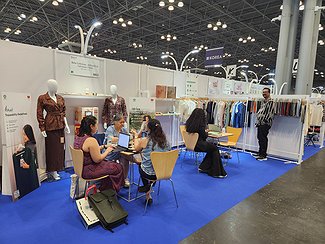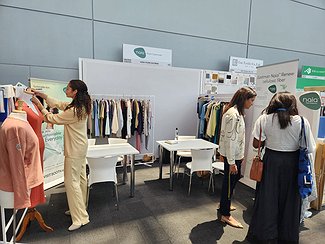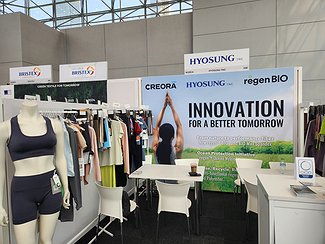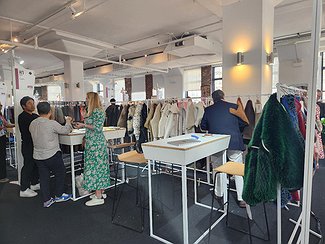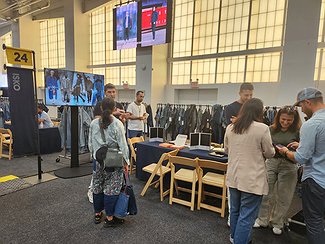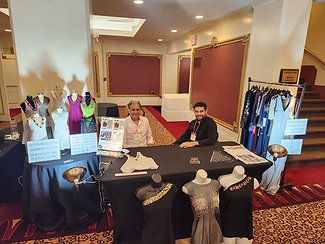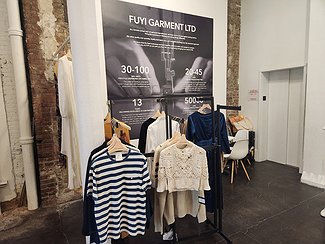Texworld and Apparel Sourcing partnered with the Investment & Trade Promotion Centre of Ho Chi Minh City Vietnam.
N.Y. TEXTILE WEEK
N.Y. Textile Week Delivers on Attendee Demands for Diverse Offerings
This season’s New York Textile Week shows offered an array of options for apparel professionals to explore fresh innovations in sourcing, manufacturing and technology in addition to reconnecting with established, trusted partners. Texworld and Apparel Sourcing, Functional Fabric Fair, powered by PERFORMANCE DAYS, Kingpins, Première Vision, the New York Fabric Show and Preface were among the events that took place July 16–18 to showcase products and services spanning an array of apparel categories.
Beyond exhibitor offerings, each show also extended educational opportunities to explore topics such as responsible sourcing and manufacturing, diversification along the supply chain, and the inspiration behind upcoming fashion trends. The distinctive missions of each of the shows were reflected in their panel discussions, information sessions and hands-on workshops, allowing visitors to increase their knowledge of targeted solutions, challenges and issues within specific apparel categories.
Texworld and Apparel Sourcing go global
Messe Frankfurt’s Texworld and Apparel Sourcing co-located shows took place July 16–18 at the Javits Center located on Manhattan’s West Side. The shows included a robust roster of global exhibitors as diversification within the supply chain remained top of mind for attendees.
“The expanded offerings and expanded countries being represented, especially now post-COVID, people are looking for alternative sourcing locations and opportunities,” said Walker Erwin, marketing manager for fashion and apparel for Messe Frankfurt, Inc.
Aaron Stout, founder and creative director of New York ready-to-wear and men’s swimwear brand Mojado, manufactures swimwear in Colombia and accessories and apparel in Asia.
“There is a lot of opportunity for growth, and I see different categories for expansion in terms of textiles and performancewear to see what’s interesting, get some ideas and see variations in different countries of production, which I think is important,” Stout said. “Some of these countries are experts in these categories.”
A number of regions that are emerging as notable sourcing and supply-chain alternatives were present at the show and were represented by organizations including the Export Promotion Bureau of Bangladesh, the Korea Textile Trade Association, TTF Taiwan and the Trade Development Authority of Pakistan. A noticeable addition to the show floor was the Investment & Trade Promotion Centre of Ho Chi Minh City Vietnam, which worked with show organizers to highlight the capabilities of the country’s apparel-making industry.
“The show has changed, especially since the pandemic,” said Jason Guanlao, who works in new-product development at Joeanne Company International, an accessories and sports-apparel manufacturer in Islandia, N.Y. “I feel there is more of a Vietnam presence here than in past years. We have a factory in the Dominican Republic, but you never know what you might need. Seeing what’s available in other areas is a good thing.”
At the booth for India-headquartered Birla Cellulose, Jen Hodo, business development manager, discussed the company’s traceable offerings in sustainable fibers. Hodo felt Birla stood out among exhibitors from other regions but noted that working together is crucial to sustainability.
“The way forward in sustainability is all about collaboration and cooperation, so that is one benefit of being at the show,” said Hodo. “We’re meeting with not only brands and retailers but also emerging designers and other suppliers. Cross functionality is the way forward. We get to engage with the industry and move forward in a sustainable way.”
Functional Fabric Fair promotes responsible performance
The Javits Center was also the site of RX Global’s Functional Fabric Fair, powered by PERFORMANCE DAYS which welcomed attendees from brands including Calvin Klein, HOKA, L.L. Bean, NOBULL, Peter Millar, Under Armour and Vineyard Vines.
“Our New York event particularly attracts a larger audience from the fashion, designer and specialty markets such as swimwear based on its setting in the fashion capital of the United States,” said Steve McCullough, event director of Functional Fabric Fair.
State of Gratitude founder Chris Bilyk searched for manufacturers and suppliers to work on his brand of apparel and accessories.
“I came to a different show a few weeks ago thinking it was going to be something like this show—and it wasn’t, so I was very happy to see this,” Bilyk explained. “I was looking for more-performance-based fabrics, eco-friendly and sustainable, and that is what’s here.”
At the Hyosung booth, Laura Nilo, West Coast marketing manager for the Seoul, South Korea–based company, noted trends in workwear, bodywear and shapewear, and scrubs as she worked with attendees from Minnesota, Chicago, Indiana, Ohio and Texas.
“It’s good to see that people are identifying the opportunity there. Healthcare workers spend a lot of time—12-hour shifts—working really hard,” Nilo said.
Sustainability was top of mind for Elyse Batista, marketing communications account manager of textiles at Kingsport, Tenn.–based Eastman, as she presented Naia, the company’s cellulosic fiber.
“It’s good to get together and learn, capture different insights when we talk to brands, trying to understand what their needs are and showing them how we can help them achieve their goals,” said Batista.
Matilda Ceesay, chief of staff at New York’s Noi Solutions, which boasts a vertically integrated factory in Bangladesh, gained insight into innovations in textiles, particularly sustainable offerings in bio-finishes, yarns, antimicrobials, temperature control and moisture wicking.
“If you want to be a leader you need to know the latest technology and make partnerships to push things forward. They have no reason to keep investing in technology if no one is buying it,” Ceesay explained, while noting interest in Cocona 37.5, CiCLO and Hyosung.
Prioritizing responsibility at Première Vision
Première Vision’s Autumn/Winter 2025–26 edition took place at the Tribeca Rooftop + 360° in downtown. The show ran July 16–17 with “sustainability and smart creation” taking priority, according to Michelle Tam, visitors marketing manager for the U.S.A., Canada and Mexico for Première Vision/GL Events.
“We strive to make the show as relevant as possible for the American market, which involves curating insightful talks on sustainability and fashion technology—topics that are rapidly gaining traction in our industry,” noted Tam.
At the Ecopel booth, Arthur Fuchs, director, met with attendees from New York, Los Angeles and Canada. Fuchs showcased the Shanghai-headquartered company’s 100 percent vegetable-based fur created from materials such as nettle, linen and hemp.
“We have many consumer and big fashion companies in America,” explained Fuchs. “It’s important to be here, close to their base, and, at the same time we can visit some of the customers who don’t have time to be at the show.”
Twenty-year industry veteran Kyoko Kikuchi has been exploring natural dyes through her New York freelance design business and hoped to connect with like-minded exhibitors.
“I was born and grew up in Japan, and the attachment to nature is different here,” Kikuchi said. “I wanted inspiration and to see recent trends. I see people trying to make [clothes] more sustainable and I am interested in the materials they are using.”
The show also attracted style-conscious attendees such as Anjelica Sauerwein, senior product development manager for hatmaker Goorin Bros. in San Francisco.
“I found lots of stuff—lots of corduroys, fancies, denim. I love seeing the new prints and lots of tech fabrics,” noted Sauerwein. “I can source so much in an hour here rather than being online and searching for days for something.”
The Solstiss Inc. booth attracted attendees from brands including Ralph Lauren and Calvin Klein, said François Damide, president.
“Some exhibitors look at ‘How many sales did we make during those two days? Was the cost versus sales worth it?’ ” said Damide. “I don’t think that way. In New York, the team is amazing—we follow up and we send scans and samples, and that is how you know it’s successful.”
Kingpins’ bluebloods flock to Basketball City
Denim-focused Kingpins hosted its New York City edition at Pier 36’s Basketball City July 17–18. The show was also a celebration of the founding of the New York event in 2004.
“It’s become this platform that is a community, educational, inspirational, yet everybody really wants to help each other,” said Vivian Wang, managing director and global sales manager.
Hayato Nishi, business development manager for denim in the Americas at Austria’s Lenzing Fibers, agreed.
“This show is all about engaging with the community and the network that we have,” said Nishi. “Even though they might be competing mills, they share information, which I love.”
Ayşe Kayabaş Çelikel, co-founder of the Turkey-based bag brand Cazular, sought new approaches to making her goods.
“I saw different fabrics, but also they did laser and other types of techniques that I have not seen before,” said Çelikel.
Turkey-headquartered ISKO exhibited at Kingpins for the first time. Los Angeles–based Massimo Callegari, senior national area manager, met with attendees from Vancouver; Atlanta; Nashville, Tenn.; and Seattle-based Tommy Bahama.
“It’s good traction and good accounts,” noted Callegari. “With the denim, they are looking for something that is raw looking; other customers are more womenswear or Tommy Bahama casualwear, or [they are] looking for something more technical, softer and drapier.”
Attendees visited the Cone Denim booth as brands explore denim apparel beyond the traditional pair of jeans, according to Pierette Scavuzzo, design director.
“While the five-pocket is still going, denim apparel is really important and you need different weights to reflect different silhouettes,” Scavuzzo explained. “Whether you’re a premium brand, specialty retailer or one of the big-box brands, you’re doing denim apparel in some form.”
7AP founder Darden Carter searched for a wash house, denim-fabric suppliers and partners that could support the Brooklyn, N.Y., brand’s nearshoring mission to make products in the U.S.
“They are super helpful and understanding where I am with my brand,” said Carter, who also took part in the Future Fit Forum as well as the mending and sewing and dye bloom workshops. “I was hammering away at flowers. It was therapeutic but also artistic.”
Down to business at Fabric Show
The New York Fabric Show hosted its latest edition July 17–18 at the New Yorker Hotel in midtown where the event’s founder, Susan Power, welcomed attendees from different areas of the apparel industry.
“Dillard’s always comes, and they were here again,” Power said. “We always get Disney’s costume people, and retail fabric stores from across the country come in such as Haberman Fabrics in the Midwest and Firecracker Fabrics.”
École Primaire’s founder, Anita Da Silva, visited the show from Ridgewood, N.Y., searching for nearshoring options for her fashion-consulting clients and her own fashion line.
“It’s so easy to work with local vendors rather than overseas,” Da Silva explained. “When a designer starts, the minimums are impossible. A lot of vendors here have stock available, and that is important for my customers.”
The Faraj Beading booth featured intricate U.S.-made embroidery and embellishment offerings from the father-and-son team of Zachary and Rommy Faraj.
“There is a lot of diversity at this show,” said Rommy Faraj. “You have us in embellishment and full private-label manufacturing, different fabrics, sportswear.”
Preface closes the loop on ‘better’ sourcing
The Fall/Winter 2025 edition of Preface NYC was hosted in a new space on 17th Street overlooking Union Square Park, a strategic move to accommodate attendees who visited multiple shows.
Olivia Schott, creative operations manager, noted that the show might have a new space but the mission remains the same.
“Our m.o. has always been to cut through the noise of the larger shows by offering a more intimate space to meet with suppliers and learn about new ideas in a digestible setting,” said Schott. “People really respond to that.”
The Fuyi Garment booth welcomed attendees from Los Angeles, New York, South America, India and China. Kit Lee, director at the Guang Dong, China factory, worked with the Preface team to streamline the supply chain for potential clients.
“People are interested in really small units of manufacturing and good quality,” Lee said. “It’s more about how we, as a manufacturing company, are here among fabric mills. It’s important to have the whole supply chain so people can look for different supplies in their processes.”

